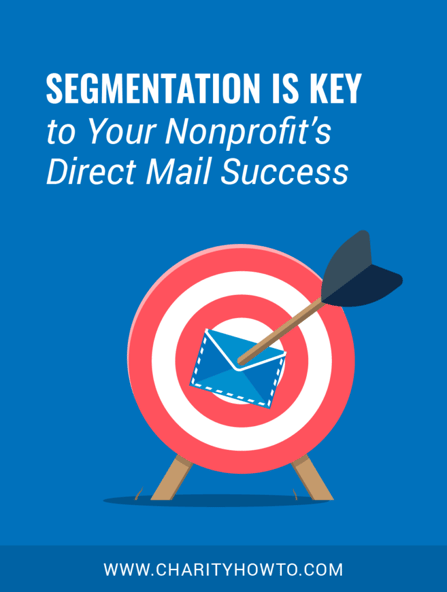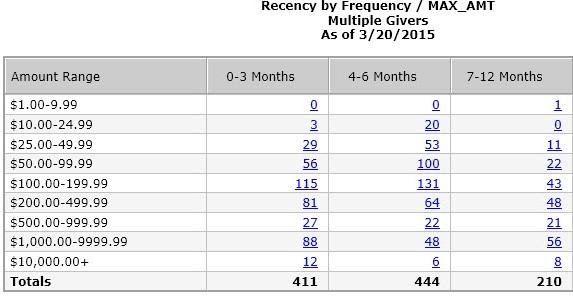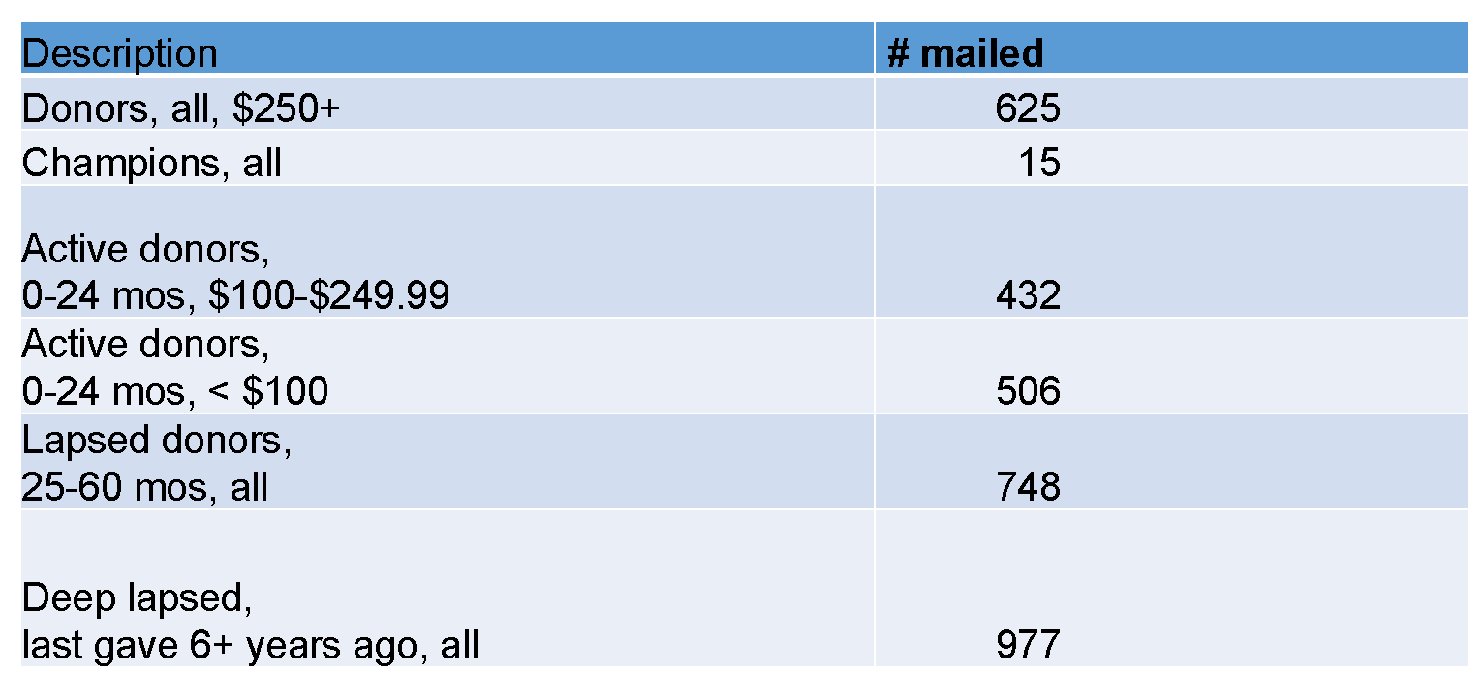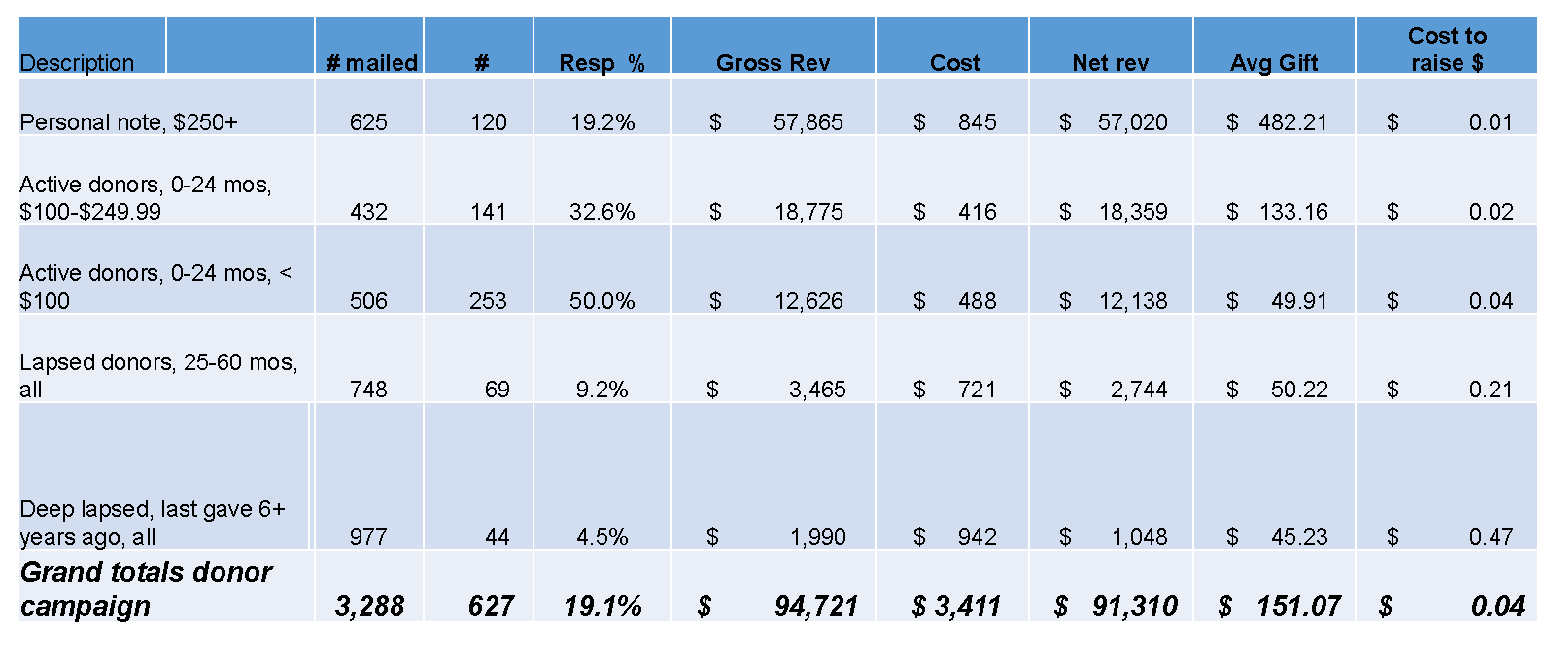Blog post by Erica Waasdorp
Did you know that 50% – 60% of your nonprofit’s direct mail results comes from whom you are mailing to? Target audience is crucial, and segmentation is just as important.

But, to determine the best target audience for your nonprofit’s direct mail, you first must determine the goal of your appeal.
For any nonprofit organization there are only three ways to grow your overall fundraising:
- You must bring in new donors to keep supporting your organization
- You must reactivate your lapsed donors because some donors deserve a second chance
- You want to give your existing donors the opportunity to give more money, more often, ongoing.
The goal of your campaign determines who your best target audience will be.
For this blog, I’m going to focus on existing donors. That’s your most responsive and most important group. They already know you (at least a little bit). Some may already love you.
So, the goal here is: how do you reach out to those donors who are most likely to make another gift by sending them a direct mail appeal?
Start by reviewing your nonprofits donor base
You may have been approached by companies that are trying to ‘sell’ you targeting analytics and modeling to ‘better segment’ your donor audience.
You may have been approached by companies that are trying to ‘sell’ you ways to create so called ‘donor personas’.
Before you commit to any of that, do yourself (and me) a favor and look at your current donor base system (CRM).
- What can it do?
- What types of reports are available?
- What segmentation options are available within the donor base itself?
If you have any of the best-known nonprofit donor base systems, most can run reports, but they may not always give you everything you need. There are many CRM systems, but here are just a few highlights: Donor Perfect, Raiser’s Edge, Etapestry, Bloomerang, Little Green Light, Neon.
If you have another system, I’d love to know what you’re using. It may be SalesForce, which can do some reporting and segmentation, but you may have to define your own reports.
Regardless what system you’re using, still start with your existing donor base system and see what you can get. There is so much you can do with your own database with just a tiny bit of time or almost no time at all, that will help you find the best target audience for your nonprofit-s direct mail!
For example, if your donor base allows you to run a Recency Frequency Monetary Value, look at it. That will give you a quick overview of your donor base. It’s typically run based upon the most recent gift or the highest previous gift.
Here’s an example of what that report looks like.

This will give you a great overview of how many donors you must work with to begin. How many donors have given in the past 3 months? How many donors have given more than $100? How many donors haven’t given in 2 years, 3 years, etc.?
This RFM report is in my opinion the most optimal report which gives you a great snapshot of your overall donor base. You can start slicing and dicing from there. Never mind donor personas, the overall trend is still: a donor who gave most recently to your organization is more likely to give to you again compared to someone who hasn’t given to you in a while.
I’ve tested this for various organizations but if you worry about reaching back to donors who gave in the last 6 months, create a segment for it and track results.
What if your donor base can’t do an RFM report? I recommend you run a simple export from your donor base, using the fields included on this check list.
You should be able to do this simply by taking your donors and making sure their last gift amount and last gift date and last gift source is included. You can then sort it by those who gave at certain levels and those who gave in certain time periods. It will take a bit more time, but it is a great way to identify how many donors you have to work with.
How do you choose those donor groups most likely to respond to your nonprofit’s direct mail?

There are four things to remember when you start your nonprofit direct mail segmentation:
1.Base your segmentation on the time of year you are sending your nonprofit direct mail appeals
The target audience for your direct mail appeals can differ depending upon the time of year. For example, at year-end/holiday time frame, you’d be wise to go a bit deeper in your donor base and try to reactivate some donors who have not given in 2 years or longer.
You could even reach out to donors who haven’t given in 5 years or longer. Especially if you don’t really know what has happened in the past with this organization, create a benchmark. Mail all segments and code them so you can track where donations come from.
2. Create a direct mail segment for your event donors
Typically, those donors who attend your gala event or those who participate in your walk/run are not necessarily the best direct mail donors.
If they are new donors, I recommend putting them in a separate segment, include them in the direct mail appeal following your event and see how they do. You’ll be able to convert some to give in the mail but not all.
Some people just want to attend your event. Having that separate segment will show you the results and you can decide. You don’t want to wait too long to try to convert them to give not only to your event but also to your appeals.
3. Create a direct mail segment for your online donors
There’s lots of great research that shows that direct mail drives donors to give online and that those online donors are more engaged if they receive both direct mail and online. So, it’s important to know who they are.
Having a special segment will help identify right off the bat how many online donors still give in the mail or go online after they receive it.
It’s also important to track your online gifts and see where they came from. If it’s direct mail only donors who gave online, they were driven there by your direct mail campaign. You should count them as a result of your campaign, but you can list them as online gifts, so you’ll know how they gave.
You’ll typically find that you would not have received a donation if it wasn’t for your nonprofit’s direct mail piece! I do see some 10 to 20% of gifts coming in online now, so it’s considerable.
4. Create a direct mail segment for those donors you’d like to treat differently, preferably higher end donors.
Every nonprofit is different in how it determines levels for its higher-end donors. For some it’s any donor who has given $100 or more. For others it’s $250 and higher, some again it can be $1,000 or more.
I typically recommend making a group that needs total personal attention when preparing a direct mail appeal to be about 250 people. Anything over that and it’s hard to create an appeal and get it out without delay. Unless you have a large board, who helps or several volunteers who’s willing to help you write personal notes.
5. Create a segment for your ‘special’ donors, like monthly givers, mid or major gift club members, etc.
Instead of a highly personalized messaging approach, you can do a laser version in the appeal, that’s aimed at the special donor segment. You can’t do that if you don’t break them out as part of your donor base segmentation when you’re preparing for your nonprofit’s direct mail appeal.
For example, for monthly donors, you can say thank you for their ongoing monthly support. And you wanted to let the donor know about this very special opportunity or project.
There are many options and segments. You want to keep it somewhat simple and oversee able for both your own sanity and that of the printer/mail house you may be working with. I manage a lot of campaigns so trust me; I know. Most recently I managed a project that had 11 letter versions and different segments with different ask amounts in the letter. That was a lot of proofing and reproofing. On average, you should be able to have 3 to 4 overall segments and then within those you can do a lot with tracking by code.
Here’s an example of different segments used for a human service organization that has great success with just 3 different letter versions and then ask amounts that are simply part of the mail merged appeal.

Track your results by segment
Finally, none of these segmentation examples and customized approaches by segment make sense if you can’t track your results.
So, if your organization is using a wallet flap remit envelope without the donor’s name/address on a piece coming back to you, keep your segments simple.
However, if you’re doing a more personalized approach with the donor information coming back to you on a reply form, you can code and track to your heart’s content! The code will be on the piece and you can just enter the donations by code and run a report to show results by code. If you know the number mailed by code and the segment description, you’re golden!
If you’re struggling with your data-entry (staff) and you are not interested in tracking by segment, keep it simple.
Here’s an example of results by segment.

There you have it. Segmentation is the absolute key for your nonprofits’ direct mail success.
It will help you determine the next steps after each appeal. You’ll always be upgrading your donors to the next level. You’ll always be optimizing the donor’s personalization to the max (as much as it fits in with your fundraising staff and resources) and your results will show.
Click here to view all upcoming Webinars by Erica Waasdorp and learn more on Direct Mail!
About The Author
Building partnerships and trying to find the best solution for donors and her clients are what Erica Waasdorp does best.
Her multi-lingual skills and multi-cultural experience bring added value to those clients interested in raising money internationally. And her experience in monthly giving has given her an edge for those clients who are ready to embark on this way of giving.
